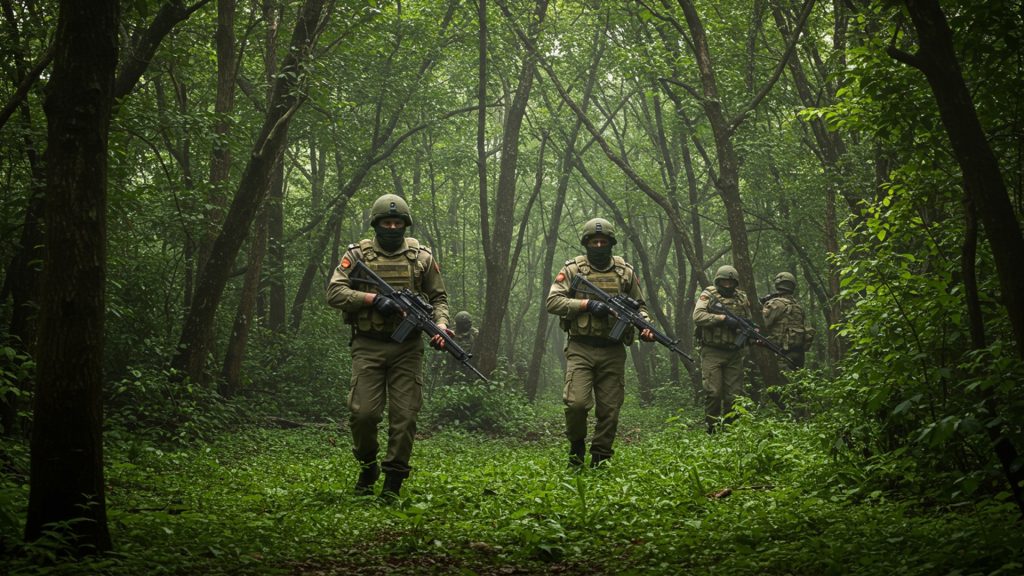Security forces are locked in a fierce gunfight with Maoist rebels deep inside Chhattisgarh today, marking a major clash in the state’s ongoing battle against insurgency. Police and paramilitary units are actively engaging the insurgents in a remote, dense jungle area, with loud gunfire echoing across the region. This intense confrontation comes amidst renewed efforts by authorities to dismantle Maoist strongholds and restore peace in the affected districts. Early reports indicate a sustained exchange of fire, highlighting the dangerous and unpredictable nature of the conflict as security operations intensify across the state.
Security Forces Act Against Maoists
In a recent development, security forces engaged in a gun battle with Maoists in the Kondagaon district of Chhattisgarh. The encounter took place in the Kohkameta village forest, part of the Bastar division, late on Friday night. The exchange of fire lasted for several minutes. During the operation, security forces recovered country-made weapons, Maoist uniforms. written materials from the site. A villager who was in the nearby area suffered a bullet injury due to the cross-fire. The injured villager received immediate medical attention at a local hospital and was later moved to Kondagaon district hospital. Officials stated that the villager’s condition is stable. Kondagaon Superintendent of Police Y. Akshay Kumar mentioned that the operation was launched based on specific data about Maoist presence in the Kanhargaon area. Forces from Bastar Fighters, District Reserve Guard (DRG). Central Reserve Police Force (CRPF) were part of this joint action. The Maoists, reportedly numbering between 10 to 12 armed individuals, had set up an ambush and opened heavy fire on the security personnel with automatic weapons, aiming to steal weapons and cause harm.
Recent Actions Against Rebels
This latest engagement follows a series of active operations by security forces in Chhattisgarh. Just days before the Kondagaon incident, on August 13, two prominent Maoists were killed in the Mohla-Manpur-Ambagarh Chowki district. These individuals, identified as Vijay Reddy and Lokesh Salame, had large rewards on their heads, totaling at least 35 lakh rupees. Vijay Reddy was a member of the Dandakaranya Special Zonal Committee of Maoists and carried a reward of ₹25 lakh, while Lokesh Salame was a divisional committee member with a reward of ₹10 lakh. This operation involved the District Reserve Guard (DRG) and took place along the Banda Pahad hill. Earlier in July, six Maoists were killed during an operation in the Abujhmad region of Narayanpur district. This operation also led to the recovery of significant weapons like AK-47 and Self-Loading Rifle (SLR), along with explosive materials. Another encounter on July 26 in the Bijapur district resulted in the elimination of four Maoist cadres. On August 12, two jawans from the District Reserve Guard (DRG) were injured in an ongoing encounter with Maoists in a forest area of Bijapur district. They were taken to a hospital in Raipur and are now out of danger.
Forces Work Together
The security forces in Chhattisgarh comprise various units working together to tackle the Maoist presence. These include the Central Reserve Police Force (CRPF), District Reserve Guard (DRG), Special Task Force (STF), Chhattisgarh Armed Force (CAF), CoBRA (Commando Battalion for Resolute Action), Sashastra Seema Bal (SSB), Indo-Tibetan Border Police (ITBP), Border Security Force (BSF). local police. These forces conduct joint operations, often based on intelligence inputs, to track and engage Maoist groups in dense forest areas. The collective efforts have led to a significant number of Maoist casualties this year. As of August 13, 2025, a total of 229 Maoists have been killed in separate encounters across Chhattisgarh. This shows an increase in the effectiveness of security operations. In 2024, 219 Maoists were neutralized in 115 engagements, marking a record for a single year. The increase in operations and successes is linked to improved coordination and the setting up of more forward base camps deep inside jungles, which helps restrict Maoist movement and enables deeper penetration by forces.
Understanding the Conflict
The Maoist insurgency, also known as Naxalism, has been a long-standing issue in parts of India, especially in the central and eastern regions, including Chhattisgarh. The movement began with an armed uprising in Naxalbari, West Bengal, in 1967. Maoists, also called Naxals, follow a form of communism and aim to bring about a total change in the existing political system. They state their fight is for the rights of marginalized and vulnerable communities, particularly tribal people, who they claim are exploited and neglected in terms of jobs, land. natural resources. They operate through armed wings, such as the People’s Liberation Guerrilla Army (PLGA). political wings. Their activities include armed attacks against government forces and workers, destroying public infrastructure like railway tracks. sometimes targeting civilians suspected of being informers.
The state of Chhattisgarh, particularly the Bastar region, is a major stronghold for Maoist activities. This region includes districts like Bijapur, Kanker, Narayanpur, Sukma, Dantewada. Kondagaon. These areas are often remote, heavily forested. lack proper connectivity, which allows Maoists to hide and operate effectively. The conflict has led to thousands of deaths over the decades, including security personnel and civilians.
How Locals Are Affected
The ongoing conflict deeply impacts the lives of common people living in the affected areas. Many residents, especially tribal communities, find themselves caught between the Maoists and security forces. They face fear and disruption to their daily lives. The conflict hinders development, leading to a lack of basic services like education, healthcare. job opportunities in these remote areas. There have been instances where civilians have been injured or killed in crossfire during encounters, as seen in the recent Kondagaon incident. Maoists also target civilians suspected of being police informers, leading to further violence. Victims of Maoist violence have recently started to voice their experiences publicly, sharing stories of lost limbs from improvised explosive device (IED) blasts and the overall suffering caused by the insurgency. These victims emphasize that due to Maoism, development in the entire Bastar region is slow. they seek freedom from this violence.
Government’s Plan to End Violence
The government has intensified its efforts to counter the Maoist insurgency, adopting a two-pronged strategy that combines robust security operations with development initiatives. Union Home Minister Amit Shah has repeatedly stated the goal to eliminate Maoist violence from the country by March 31, 2026. The state government, under Chief Minister Vishnu Deo Sai, has also committed to this goal, stating that the fight is not just with weapons but also through development, education. employment. Key aspects of the government’s strategy include:
- Deployment of Central Armed Police Forces (CAPFs) and state police in affected areas.
- Formation of special anti-Maoist units like the District Reserve Guard (DRG) and Special Task Force (STF).
- Improved road connectivity to allow security forces to reach previously inaccessible areas and set up new camps. For example, between December 2023 and April 2024, CRPF opened 20 new camps in the Sukma-Bijapur region.
- Focus on providing basic amenities to villagers from these new security camps, aiming to build trust and gather support from local residents.
- Development programs focusing on education (like Eklavya Model Residential Schools for tribal children), skill development. infrastructure projects in affected districts.
The increased number of Maoist casualties in recent times is seen by officials as a sign of success in these intensified operations.

